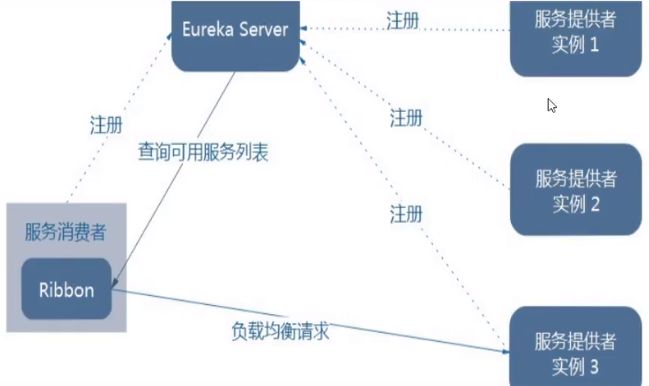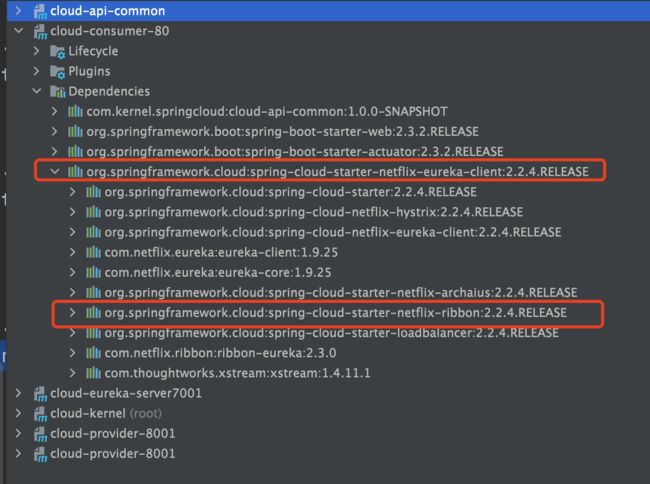Spring Clould之客户端负载均衡(Ribbon)详解
文章目录
- Ribbon入门介绍
-
- Ribbon概述
- 负载均衡器组件
- Ribbon实现负载均衡原理
- Ribbon的负载均衡和RestTemplate调用
- Ribbon默认自带的负载规则
- Ribbon负载规则替换
- Ribbon默认负载轮询算法原理
- RoundRobinRule源码分析
- Ribbon之手写轮询算法
Ribbon入门介绍
Ribbon概述
Spring Cloud Ribbon是基于Netflix Ribbon实现的一套客户端 负载均衡的工具。
Ribbon是Netflix发布的开源项目,主要功能是提供客户端的软件负载均衡算法和服务调用。Ribbon客户端组件提供一系列完善的配置项如连接超时,重试等。
简单的说,就是在配置文件中列出Load Balancer(简称LB)后面所有的机器,Ribbon会自动的帮助你基于某种规则(如简单轮询,随机连接等)去连接这些机器。我们很容易使用Ribbon实现自定义的负载均衡算法。
简单的说就是将用户的请求平摊的分配到多个服务上,从而达到系统的HA (高可用)。
常见的负载均衡有软件Nginx,LVS,硬件F5等。
负载均衡器组件
- 一个负载均衡器,至少提供以下功能:
- 要维护各个服务器的IP等信息
- 根据特定逻辑选取服务器
- 为了实现基本的负载均衡功能,Ribbon的负载均衡器有三大子模块:
- Rule:负载均衡规则
- Ping:心跳检测
- ServerList:需要再ribbon保存完整服务器IP集合,只有知道了信息集合才能知道如何使用Rule
Ribbon实现负载均衡原理
LoadBalancerClient
LoadBalancerClient是负载均衡器的核心类,它可以通过eureka- client获取到负载均衡服务提供者的实例信息,并将服务注册列表信息缓存一份,从而实现了客户端的负载均衡。
Ribbon的负载均衡主要是通过LoadBalancerClient来实现的,而 LoadBalancerClient具体交给了ILoadBalancer来处理,ILoadBalancer通过配置IRule,IPing等,向Eureka Client获取注册列表信息,默认每10秒向Eureka Client发送一次「ping」 ,进而检查是否需要更新服务的注册列表信息。最后,在得到服务注册列表信息后,ILoadBalancer根据IRule的策略进行负载均衡。
RestTemplate增加@LoadBalance注解后,在进行远程调度时能够做到负载均衡,主要是维护了一个被@LoadBalance注解的 RestTemplate列表,并给该列表中的RestTemplate对象添加了拦 截器。在拦截器方法中,将远程调度方法交给了 Ribbon的负载均衡器LoadBalancerClient去处理,从而实现了负载均衡的目的。
Ribbon的负载均衡和RestTemplate调用
Ribbon其实就是一个软负载均衡的客户端组件,它可以和其他所需请求的客户端结合使用,和Eureka结合只是其中的一个实例。

Ribbon在工作时分成两步:
第一步先选择EurekaServer ,它优先选择在同一个区域内负载较少的server。
第二步再根据用户指定的策略,在从server取到的服务注册列表中选择一个地址。
其中Ribbon提供了多种策略:比如轮询、随机和根据响应时间加权。
Ribbon依赖
先前工程项目没有引入spring-cloud-starter-netflix-ribbon也可以使用ribbon。
<dependency>
<groupld>org.springframework.cloudgroupld>
<artifactld>spring-cloud-starter-netflix-ribbonartifactid>
dependency>
这是因为spring-cloud-starter-netflix-eureka-client自带了spring-cloud-starter-netflix-ribbon引用。
官方文档:https://docs.spring.io/spring-framework/docs/5.2.2.RELEASE/javadoc-api/org/springframework/web/client/RestTemplate.html
getForObject() / getForEntity() - GET请求方法
getForObject():返回对象为响应体中数据转化成的对象,基本上可以理解为json。
getForEntity():返回对象为ResponseEntity对象,包含了响应中的一些重要信息,比如响应头、响应状态码、响应体等。
@GetMapping("/consumer/getForEntity/{id}")
public RestResult<UserTest> getUser(@PathVariable("id") Long id){
ResponseEntity<RestResult> entity = restTemplate.getForEntity(BASE_URL + "/get/" + id, RestResult.class);
// is2xxSuccessful 成功状态
if(entity.getStatusCode().is2xxSuccessful()){
return entity.getBody();//getForObject()
}else{
return RestResult.fail(ResultCode.DATA_ACCESS_ERROR);
}
}
postForObject() / postForEntity() - POST请求方法
Ribbon默认自带的负载规则
lRule:根据特定算法中从服务列表中选取一个要访问的服务
- RoundRobinRule 轮询。
- RandomRule 随机。
- RetryRule 先按照RoundRobinRule的策略获取服务,如果获取服务失败则在指定时间内会进行重试,获取可用的服务。
- WeightedResponseTimeRule 对RoundRobinRule的扩展,响应速度越快的实例选择权重越大,越容易被选择。
- BestAvailableRule 会先过滤掉由于多次访问故障而处于断路器跳闸状态的服务,然后选择一个并发量最小的服务。
- AvailabilityFilteringRule 先过滤掉故障实例,再选择并发较小的实例。
- ZoneAvoidanceRule 默认规则,复合判断server所在区域的性能和server的可用性选择服务器。
Ribbon负载规则替换
1.修改cloud-consumer-80
2.新建配置类
@Configuration
public class MySelfRule {
@Bean
public IRule myRule() {
return new RandomRule(); // 随机
}
}
主启动类添加@RibbonClient
@SpringBootApplication
@EnableEurekaClient
@RibbonClient(name = "cloud-provider-service", configuration = MySelfRule.class)
public class ConsumerApplication {
public static void main(String[] args) {
SpringApplication.run(ConsumerApplication.class,args);
}
}
然后访问cloud-provider-service服务就是随机的。
Ribbon默认负载轮询算法原理
默认负载轮训算法: rest接口第几次请求数 % 服务器集群总数量 = 实际调用服务器位置下标,每次服务重启动后rest接口计数从1开始。
有俩台机器
- 127.0.0.1:8002
- 127.0.0.1:8001
8001+ 8002组合成为集群,它们共计2台机器,集群总数为2,按照轮询算法原理:
- 当总请求数为1时: 1%2=1对应下标位置为1,则获得服务地址为127.0.0.1:8001
- 当总请求数位2时: 2%2=0对应下标位置为0,则获得服务地址为127.0.0.1:8002
- 当总请求数位3时: 3%2=1对应下标位置为1,则获得服务地址为127.0.0.1:8001
- 当总请求数位4时: 4%2=0对应下标位置为0,则获得服务地址为127.0.0.1:8002
- 如此类推…
RoundRobinRule源码分析
package com.netflix.loadbalancer;
import com.netflix.client.config.IClientConfig;
import org.slf4j.Logger;
import org.slf4j.LoggerFactory;
import java.util.List;
import java.util.concurrent.atomic.AtomicInteger;
/**
* The most well known and basic load balancing strategy, i.e. Round Robin Rule.
*
* @author stonse
* @author Nikos Michalakis
*
*/
public class RoundRobinRule extends AbstractLoadBalancerRule {
private AtomicInteger nextServerCyclicCounter;
private static final boolean AVAILABLE_ONLY_SERVERS = true;
private static final boolean ALL_SERVERS = false;
private static Logger log = LoggerFactory.getLogger(RoundRobinRule.class);
public RoundRobinRule() {
nextServerCyclicCounter = new AtomicInteger(0);
}
public RoundRobinRule(ILoadBalancer lb) {
this();
setLoadBalancer(lb);
}
// 重点关注这方法。
public Server choose(ILoadBalancer lb, Object key) {
if (lb == null) {
log.warn("no load balancer");
return null;
}
Server server = null;
int count = 0;
while (server == null && count++ < 10) {
// 只有已启动且可访问的服务器。
List<Server> reachableServers = lb.getReachableServers();
// 所有已知的服务器,包括可访问和不可访问的服务器。
List<Server> allServers = lb.getAllServers();
int upCount = reachableServers.size();
int serverCount = allServers.size();
if ((upCount == 0) || (serverCount == 0)) {
log.warn("No up servers available from load balancer: " + lb);
return null;
}
// 获取下标
int nextServerIndex = incrementAndGetModulo(serverCount);
// 获得服务
server = allServers.get(nextServerIndex);
if (server == null) {
/* Transient. */
Thread.yield();
continue;
}
if (server.isAlive() && (server.isReadyToServe())) {
return (server);
}
// Next.
server = null;
}
if (count >= 10) {
log.warn("No available alive servers after 10 tries from load balancer: "
+ lb);
}
return server;
}
/**
* Inspired by the implementation of {@link AtomicInteger#incrementAndGet()}.
*
* @param modulo The modulo to bound the value of the counter.
* @return The next value.
*/
private int incrementAndGetModulo(int modulo) {
for (;;) {
int current = nextServerCyclicCounter.get();
int next = (current + 1) % modulo;// 求余法
// CAS 比较并交换
if (nextServerCyclicCounter.compareAndSet(current, next))
return next;
}
}
@Override
public Server choose(Object key) {
return choose(getLoadBalancer(), key);
}
@Override
public void initWithNiwsConfig(IClientConfig clientConfig) {
}
}
Ribbon之手写轮询算法
public interface LoadBalancer {
/**
* 轮训获取服务
* @param serviceInstances
* @return
*/
ServiceInstance instances(List<ServiceInstance> serviceInstances);
}
@Service
public class MyLb implements LoadBalancer {
private AtomicInteger atomicInteger = new AtomicInteger(0);
/**
* 轮训获取服务
* 负载均衡算法:rest接口第几次请求数 % 服务器集群总数量 = 实际调用服务器位置下标 ,每次服务重启动后rest接口计数从1开始。
* @param serviceInstances
* @return
*/
@Override
public ServiceInstance instances(List<ServiceInstance> serviceInstances) {
int index = getAndIncrement() % serviceInstances.size();
return serviceInstances.get(index);
}
// 第几次访问
public final int getAndIncrement() {
int current;
int next;
do {
current = this.atomicInteger.get();
next = current >= 2147483647 ? 0 : current + 1;
} while (!this.atomicInteger.compareAndSet(current, next));
System.out.println("*****第几次访问,次数next: " + next);
return next;
}
}


